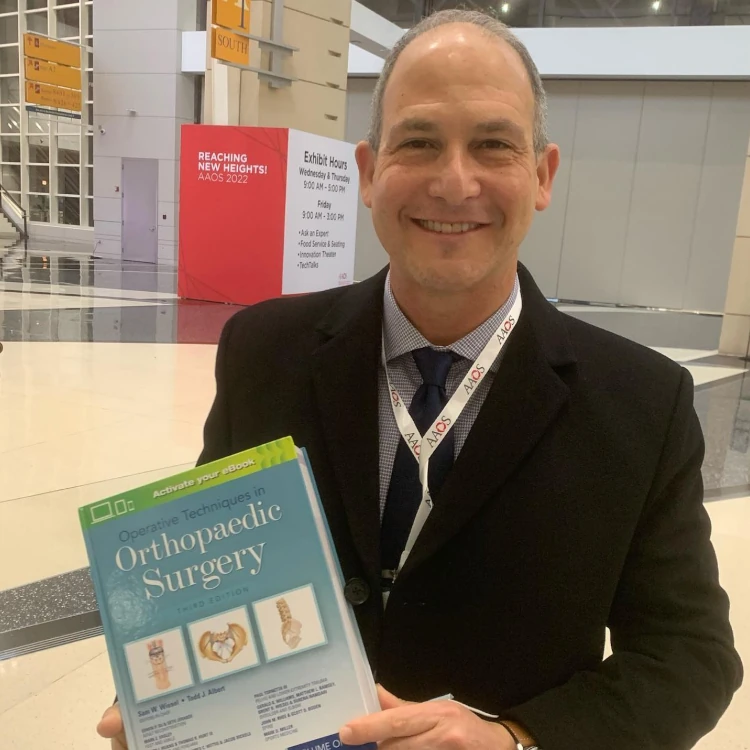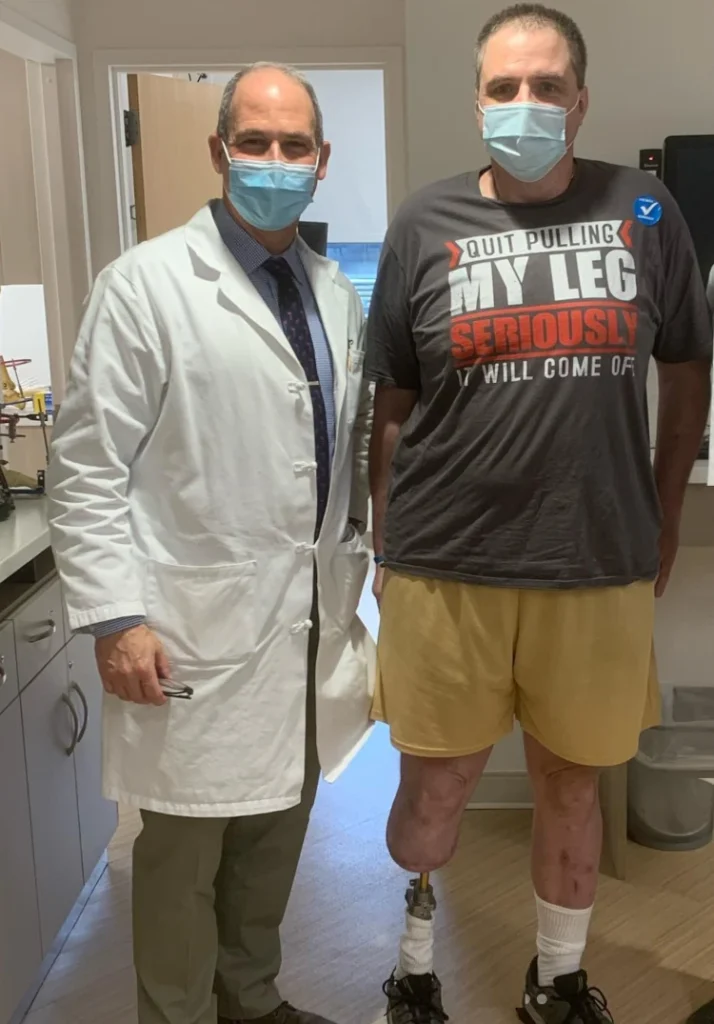“The first year I did osseointegration, about six years ago, I did two or three OI procedures the entire year,” says orthopedic surgeon Robert Rozbruch. “Now I’m doing two or three a month. My growth has been exponential, and I imagine that’s the kind of explosive growth the country will see over the next 10 years.”
The bone doc is bullish on OI for several reasons, but one of the biggest is the expanding range of patients who are getting good results from the procedure. When Rozbruch got started as one of the first OI surgeons in the country, the operation was performed almost exclusively on above-knee amputees at the younger, fitter end of the spectrum. But successful OI outcomes are now becoming commonplace in patients who fall outside that fairly narrow profile—including patients who are over 70 years old, who have diabetes, who have below-knee amputations, or who face other adverse indications for OI.
Rozbruch describes himself as “the kind of surgeon who is willing to go on the journey” with a patient—meaning he will operate on someone with a less-than-perfect risk profile, as long as the patient understands the odds and accepts their share of responsibility for optimizing outcomes. As chief of the Limb Lengthening and Complex Reconstruction Service at New York’s Hospital of Special Surgery, he’s accustomed to exploring new medical frontiers. OI is one of the latest iterations of that.
We spoke with Rozbruch last month about his experience with OI and his expectations for the future. The conversation has been edited for clarity and length. Learn more about the Limb Lengthening Service’s osseointegration program at HSS website. For a deeper dive on osseointegration, see Amplitude‘s September 2022 feature, “Opting for Osseointegration.”
The FDA’s authorization for OI only covers patients up to age 65. Will we see that upper boundary move upward?
I don’t think age is a meaningful indicator. What’s really much more relevant is the quality of the bone. Amputees in sockets do not load-bear on the bone, so localized osteopenia sets in and the quality of the bone becomes dramatically worse [for receiving an OI implant]. When I’m dealing with a bone that is six months or a year post-amputation, compared to one that’s been in a socket for 20 years, it’s a completely different ballgame. So when you compare a 65-year-old who had an amputation six months ago to a 35-year-old who had an amputation 15 years ago, who do you think has better bone for OI?
I’m guessing the 65-year-old.
Exactly. I personally have done OI surgery on patients into their 70s. We haven’t seen any differences in OI success in an older population versus a younger population, and we have a large enough group [of patients] now that we can start to stratify the groups. You can say whether length of bone is an indicator of success, whether age is an indicator of success, whether a history of infection is a predictor of success. We have not found any of those things to be a predictor of success. What we have found is that the sooner you do it [after limb loss], the better the outcomes are.
Help me understand the mechanics of that.
Wolff’s Law basically states that when a bone is loaded, it becomes stronger and it builds more bone. And when it’s not loaded, it becomes weak. One example of that is that when an astronaut is in space too long, in an environment that does not have gravity, their bones become osteopenic. We also know that during bone healing [from a fracture, e.g.], some weight bearing is important.
If you do OI earlier in the process, the bone is being loaded sooner and you have the potential to preserve bone quality. For an older patient, that means they can have more control of their residual limb, they’re better able to avoid falling, and they have more stability, more control, and more proprioceptive sensation. Those are advantages for all groups, but maybe especially important for older patients.
So if I’m an amputee who has been waiting maybe seven or eight years for OI to get FDA approval—that whole time I was waiting, my bones were getting weaker and making me a less suitable candidate for OI? Am I hearing that right? How do I find out if my residual limb has become too osteopenic to receive an implant?
We have done OI on all comers. I’ve had patients who are as much as 30 years out from their amputation, and whose bones have been quite osteopenic. But to answer your question: We always do a CT scan to measure bone thickness so we can custom-fit the size of the implant to the bone. The implant has to fill the entire canal. The implant I put in somebody who’s osteopenic tends to be thicker than the one I put into somebody who is not osteopenic, because there’s more room in the canal. The pipe has a thinner wall, as opposed to a thick wall and a tight canal.
Another thing we can do in patients who are really osteopenic is to use a bone-forming agent after implantation. The concept is not much different from doing a total hip replacement on somebody who has osteoporosis—you want to enhance the growth of the bone into the implants. Forteo is a good example of a medication that encourages osteoblasts to grow. It’s an anabolic agent, basically. We’ve been selectively using that on patients, with the help of a metabolic bone disease endocrinologist, to enhance bone formation. And we are seeing increases in bone quality.
The advantage of doing this in somebody who is quite osteopenic, is that now you have an opportunity to start loading the bone and building it up. Even if somebody has been an amputee for 20 years, they might still have many years ahead of them. So OI prevents that bone from becoming even more osteopenic. So far, we have seen any evidence of inferior outcomes in older patients or patients whose bone quality is not as good.
A big segment of Amplitude‘s readership are people who lost limbs due to diabetes or vascular disease. When they consider OI, they’re concerned not only about bone quality but also the risk of infection. What has your experience been like with patients in that group?
Most of my experience is on post-traumatic patients, as opposed to patients who’ve lost legs for vascular reasons. I don’t have a lot of personal experience doing it for vascular patients. However, I have seen some post-traumatic patients who also have diabetes. So I would answer your question by saying that if you have well-controlled diabetes—meaning your H1Cs are normal—then you’re not much different from a patient who doesn’t have diabetes.
We’ve learned that from general surgery and surgical care. I have 25 years of experience putting on external fixators, and external fixation pins are very well tolerated in diabetic patients, as long as they have well-controlled diabetes. So I think the issue is not so much diabetes versus non-diabetes. It’s poorly controlled diabetes versus all other patients. If somebody’s got poorly controlled diabetes, OI’s not going to be a good option for them.
Suppose I bring my diabetes under control? Let’s say I’m a middle-aged person who developed Type II diabetes, lost a limb, and now I’m spending a lot of time in a wheelchair or on my couch. Maybe I have a prosthesis, but it’s hard for me to use it much because of my health issues. If I start getting healthier, could I eventually become a good candidate for OI? Or is there some point of no return that gets crossed, where I might never have a reasonable chance for a successful outcome?
That’s a tough question. Some surgeons are very cautious, and some are willing to work with the patient. I’m one of those people. I try to give hope to patients. I try to be honest, so if something’s a bit more risky for them, I’ll tell them. But I’m generally the kind of surgeon who will go on the journey with somebody, as long as they’re well informed.
What I’ve learned over the years is that people can get people get pretty motivated when they’re hopeful. I just operated on a guy from Wisconsin. He wasn’t diabetic, but he was definitely not doing great. He became addicted to painkillers after his amputation, put on weight, spent a lot of time in his wheelchair. So when I met him, I was really wondering whether OI was the right thing for this guy. But he wanted to work with me. I gave him a target on how much I wanted his narcotics to come down, and he did it. I gave him a target on how much weight I wanted him to lose, and he did that too. To me, he was a good example of somebody who might not look like a good candidate on the surface. But if I see they have a spark of motivation to make some changes in their life, and I think I can help them, that can actually be extremely gratifying.
I think there are probably a lot of people like that out there. Maybe they were motivated initially when they got a prosthetic leg, but then it’s extremely deflating if the prosthesis doesn’t restore their mobility. OI does give people new hope for a better quality of life, and I do think that’s motivating.
It’s not only motivating for patients. I’ve been in this business for a long time. Among doctors, amputations were always viewed as a failure. That’s how it has been viewed in the surgical community. But osseointegration has created a real buzz. It’s making [limb removal] an exciting reconstructive operation, as opposed to a sort of failure. That’s been an interesting phenomenon to observe.
Here’s another very interesting thing. We have a lot of medical students who want to get involved in research projects. And I have a queue of about six medical students who want to do research with me this summer. And specifically, they’re interested in working with me on osseointegration. So it’s catching the attention of the new generation as well. Little by little, more and more surgeons will be trained to do OI, and more and more patients will benefit.






